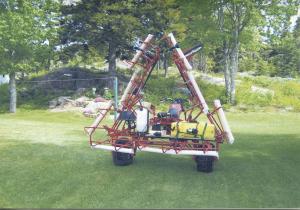2012 - Volume #36, Issue #3, Page #26
[ Sample Stories From This Issue | List of All Stories In This Issue | Print this story
| Read this issue]
ATV Converted Into Self-Propelled Wick Wiper
 |
 |
He uses the wick wiper to apply Roundup to weeds on his wild blueberry farm, where he grows 60 acres of blueberries and also leases land from neighbors. “These are low bush blueberries that grow wild on fields that have never been plowed or tilled, so some of the ground can be rough. The blueberries grow only 10 to 11 in. high, and we needed a better way to control weeds that grow above the crop,” says Perry.
“I had been using a commercial pull-type wick wiper behind an ATV, but it was only 6 ft. wide and my wife had trouble backing it up. My home-built wick wiper is built into the ATV, which makes it easy to back up. It has a lot of adjustable features on it, which is important because the goal is to get as close as I can to the blueberries without touching them.”
The boom is built from 1-in. box tubing and is designed in 3 sections that fold inward for transport. Gauge wheels at each end allow the boom to follow uneven ground contours.
Each section contains three 2-ft. long Smucker sponge wipers. A linear actuator is used to raise and lower each section, and manifolds are used to saturate the wipers in each section individually. The boom is equipped with a 15-gal. chemical tank and a 12-volt pump, as well as a foam marker tank. An electric winch is used to raise and lower the sections for transport, with a pair of garage door springs keeping tension on the cable in the field as the boom bounces up and down. A control panel located next to the ATV’s seat controls all operations.
The ATV itself got a real makeover, as Perry widened, lengthened, and raised it. He removed the rear wheels from the ATV, and then bolted a frame made from box tubing to the back part of the ATV frame. Then he remounted the rear wheels on the frame, spacing them 8 ft. apart and 2 ft. back from their original position.
He added a differential on back of the ATV that gears the rig down at a 5 to 1 ratio and lets him drive very slowly through the field. The conversion involved mounting a sprocket on the ATV’s original rear axle, which is used to chain-drive the differential. “I use a homemade hand throttle to control the speed. Top speed is just 10 mph,” says Perry.
He bought another set of front forks and welded them onto the original forks to raise the machine by 12 in.
“Raising the ATV keeps it from bending the weeds over before the wicks get to them. And widening the ATV reduces the number of tire tracks across the field and helps stabilize the wiper,” says Perry. The sponge wipers float individually, “which is important because the ground these wild blueberries grow on is often quite hummocky,” says Perry. Each wiper attaches to a pair of metal bars that are bent at the bottom to serve as skids. The height of each wiper can be adjusted by changing the position of a pair of light chains that fit into slots cut into the frame.
“Early in the season the blueberry bushes are lower, which is when I lower the wipers. Later in the season, I can raise the wipers in 1-in. increments.”
Perry not only grows wild blueberries but also operates a processing factory, which allows him to sell boxes of frozen blueberries. “In 2011 we bought a former seafood processing factory that we equipped with freezers, coolers and space for expansion. We also removed boulders and leveled our fields. We even bring in bees to help the native pollinators,” he notes.
Contact: FARM SHOW Followup, Leon Perry, P.O. Box 79, Addison, Maine 04606 (ph 207 461-6531; lpdaughters@aol.com; www.perryswildblueberryfarm.com).

Click here to download page story appeared in.

Click here to read entire issue
To read the rest of this story, download this issue below or click here to register with your account number.




